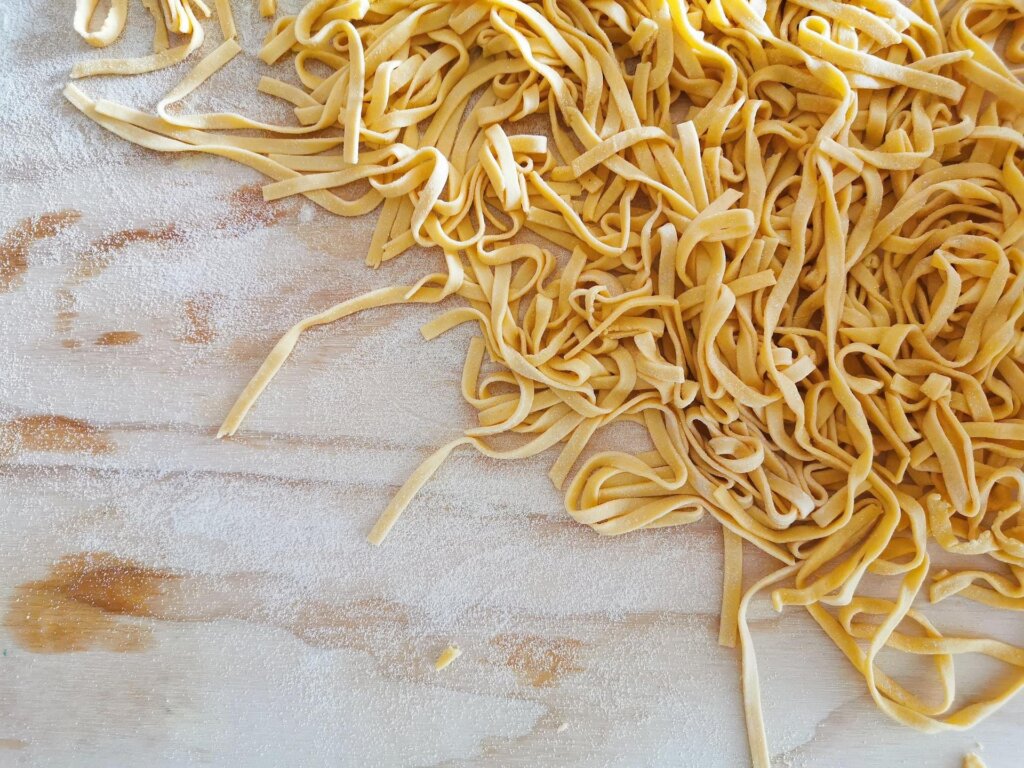Muscle Mac

Few staples are as highly prized as satisfying and filling pasta.
But pasta has quite a reputation as a comfort food for carb lovers. And it’s often one of the first foods people cut out of their diet when they try to cut fat and gain muscle.
Does dropping pasta from a high-protein diet make sense? Or is pasta high in protein?
Pasta actually has high levels of protein compared to other carbohydrates. Further, the flour is often fortified with key vitamins and minerals (although these nutrients vary from brand to brand). The glycemic index of pasta is only in the low to medium range — and that includes refined types, not just whole-grain pasta. Pasta has even been linked to improved diet quality in Americans.
Whether it’s made with wheat flour or eggs, a high-quality brand of pasta is an excellent source of protein in your diet. Read on to learn how much protein is in pasta and how to get even more protein from your pasta meals.
Pasta has more protein than you might realize. A 2-ounce (oz.) serving of whole wheat pasta contains 8g of protein. And regular white pasta, regardless of its egg content, still clocks in at 7g of protein per 2-oz. serving.
Compared to other popular carbs, pasta has a high level of protein:
If you want to boost the protein content of your pasta even higher, you can choose from specially formulated protein pasta varieties. High-in-protein pasta products sometimes contain double or triple the levels of protein of traditional pasta. And they still provide slow-release energy from the carbohydrate content.
These new pasta products, made with natural high-protein ingredients such as beans and lentils, are becoming increasingly available in stores. “Protein pasta” is often similar in taste and texture to traditional wheat pasta. This makes it easy to use the same pasta recipes and sauces you know and love.
But how many grams of protein are in pulse- or bean-based pasta? Although ingredients vary between brands, here are the amounts in some more popular protein pasta sources:
Pasta is also sometimes made from edamame, mung beans, peas, or other pulses. However, most protein pasta brands have one thing in common — being expensive.
There’s another way you can add a protein punch to your daily diet while enjoying a classic pasta favorite. Founded by Quality Pasta Company, Muscle Mac offers a range of high-protein, comforting mac & cheese meals made from natural ingredients. Take the Mac & Cheese Original Cheddar. At just $2.79 per serving, it contains a blend of durum wheat semolina, pea protein isolate (a complete protein), and whey. These ingredients provide the Original Cheddar with 20g of protein per 3.6-oz. serving — enough to compete with any other protein-rich pasta option.
Even though regular pasta contains a higher amount of protein than many people expect, it’s not generally thought of as one of the best protein sources. Pasta will help you maintain strength, but it’s not a complete protein. This means it’s lacking in some of the essential amino acids you need for muscle growth. As such, relying on pasta alone probably won’t help you reach your fitness goals.
Serving your pasta alongside other sources of protein will help you achieve a better balance of all nine essential amino acids.
You can easily make high-protein pasta meals at home by getting creative with additional protein sources. You can even add extra ingredients, such as chicken or pulled pork, to a portioned meal like Muscle Mac Mac & Cheese.
Serving your pasta with a comforting lean meat sauce is an easy and delicious way to get more of the essential amino acids your body needs. You can pair it with any of your favorite pasta shapes — tubes, ribbons, corkscrews, or something else.
This easy spaghetti meat sauce recipe uses cupboard staples like onion, cumin, and marinara sauce. As instructed, simply mix in sauteed ground beef to thicken the mixture and boost the protein contents.
For a lighter lunchtime meal that’s lower in saturated fat, top your pasta with a portion of lean meat or fish. Chicken, shrimp, or salmon are all delicious options to boost the protein content of your pasta salad.
Combine salmon with cucumber, tomatoes, and a lemon vinaigrette. Mix chicken breast with bacon, spinach, and feta. Add cheese to your pasta, and you’ll create an extra-high protein pasta dish. The possibilities are endless.
If you’re a vegetarian or a vegan, you can still add extra protein to your cooked pasta dish. Opt for a protein-rich option — such as beans, tofu, or peas — and pair it with your favorite sauce. Unprocessed plant-based options are also a great choice if you’re looking to reduce the saturated fat in your diet, especially as pasta itself is low in fat.
Keep things simple and fresh by mixing spaghetti with cannellini beans, garlic, olive oil, and basil leaves. Top it with high-protein plant-based cheese to add more grams of protein.
Muscle Mac is a simple way to add more protein to your daily diet — we use proteinous, high-quality pasta in each meal. All of our boxes and cups contain 20g of easy protein, without the need to cook an elaborate meal or add extra ingredients.
Whether you’re an older adult, bodybuilder, or someone looking to get in better shape, take a look at our full range of delicious Mac & Cheese dishes.